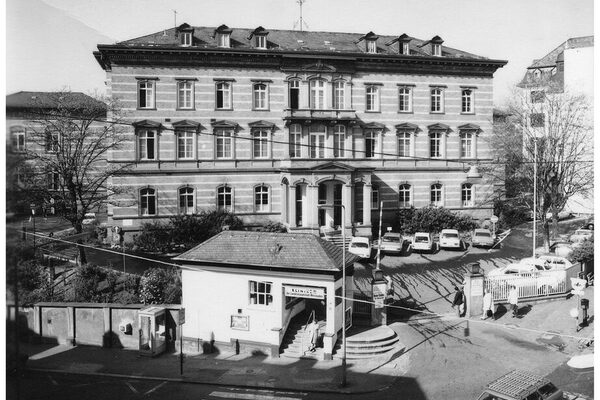Municipal hospitals
With the hospital contract of February 18, 1874, the former Wiesbaden civil hospital was transferred to municipal ownership and a new building of the now dilapidated hospital was stipulated.
The hospital was opened on the site of the former Roman fort on Platter and Schwalbacher Strasse on 16.04.1879. The clinic with 160 beds was built according to the pavilion concept, which provided for the spatial separation of different medical areas in order to contain the risk of infection. Until the First World War, the municipal hospitals were extended and enlarged by numerous departments and the number of beds rose to over 600. After 1918, the financial and economic crisis almost brought operations to a standstill. The reconstruction driven forward by the National Socialists was halted by the Second World War. At the beginning of the war, 600 beds had to be kept available as a military hospital reserve. In the last year of the war, only 230 beds were available to the civilian population after heavy destruction caused by Allied air raids.
After the end of the war, the individual departments moved into various temporary premises. For example, the children's department was moved to Schwalbacher Straße, the women's clinic to what is now the Antoniusheim and parts of the medical clinic to the Taunusheim, which belonged to the Chausseehaus.
At the beginning of the 1950s, the old buildings were gradually rebuilt. When the ceremony to mark the 75th anniversary of the municipal hospitals took place on July 11, 1954, the facility had 600 employees and 1,100 beds. After additional buildings were erected in the mid-1950s for the X-ray department, the surgical outpatient clinic and the emergency outpatient department, there was no more space for further new buildings on the site on Schwalbacher Strasse. In 1957, Medical Clinic I with 100 beds, which mainly treated patients with diabetes and gastrointestinal diseases, was relocated to the former sanatorium in Nerotal. In the 1960s, the Neurological-Psychiatric Clinic and the Pathology Department had to move to other municipal buildings in order to meet the clinic's increasing bed requirements.
At the end of the 1960s, consideration was given to a change of location. In November 1973, the decision was made to build a new building on a 22-hectare site on the Freudenberg, which the city acquired from the federal government. The foundation stone for the new hospital was laid on December 2, 1976 and the facility, which cost DM 273 million, was handed over to the city on October 18, 1982. At this time, the clinics had a total number of beds of 818. The medical complex was named Dr. Horst Schmidt Kliniken(Helios Dr. Horst Schmidt Kliniken) after the Hessian Minister of Social Affairs, who was committed to the new building.
Literature
Müller-Werth, Herbert: Municipal hospitals, Wiesbaden 1975.
Peters, Helge; Weber-Schnee, Beate: 125 Jahre Klinikum der Landeshauptstadt Wiesbaden, Wiesbaden 2004.
Collection of newspaper clippings from the Wiesbaden city archives, "Städtische Krankenanstalten".
